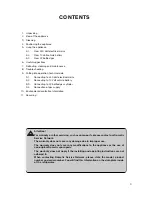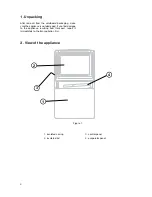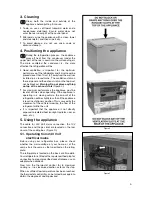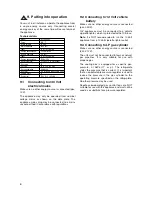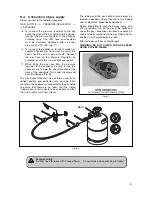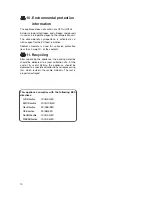
7
6. Useful suggestions
When setting out on a trip, run the appliance on
240 V for 24 hours prior to departure. Place food in
a pre-cooled condition into the appliance.
Frost forms on the evaporator panel when in
operation. When opening the lid or putting in food,
some of this frost melts and collects in the form of
water on the bottom of the appliance. Wipe the
water off occasionally using a sponge.
Avoid putting foods with fragile packaging (such as
glass) into the refrigeration unit. Movements and
shaking of the unit may cause these items to break.
Once the cooling box is in its permanent position,
make sure foods do not come into contact with the
evaporator panel, as this can cause freezer-burn to
the foods.
The appliance is not operated on 12 Volts when
your vehicle is parked, otherwise you will drain the
battery in a short time.
Only one power source is used at a time to run the
appliance.
7. Defrosting, cleaning and
maintenance
For defrosting, always unplug the appliance from an
electrical power source to avoid the risk of shock.
Make sure no other power source is connected (gas
or 12V). Remove food from the refrigeration unit and
leave the lid open. Depending on the temperature,
frost melts in a short time from the evaporator panel,
with water collecting at the bottom of the appliance.
Wipe it off using a towel. Afterwards, clean the
appliance by following the instructions in section 3.
Leave the lid ajar to prevent any odours from forming.
The appliance is serviced depending on use, at least
once a year by an authorised service agent.
8. Trouble shooting
Before calling a service technician please check
carefully the operating instructions, service booklet
and the warranty terms and conditions:
Are location and ventilation satisfactory?
Is the appliance level?
Is there a current in the wall socket and is the
connection suitable for the appliance?
Is the mains power cable damaged?
For mains operation, is the electric thermostat
swiched on?
For gas operation, was the safety valve knob
pressed down long enough?
Is the thermostat knob set towards the maximum
position?
Is the gas cylinder or the pressure regulator
valve open?
Is there any gas in the cylinder? (If by shaking,
no liquid movement can be detected, then the
cylinder is empty.)
Is more than one power source connected (such
as gas or electricity)?
Was warm food placed in the unit?
Was a large quantity of food put in at one time?
Summary of Contents for RC 1600 EGP
Page 11: ...11...



